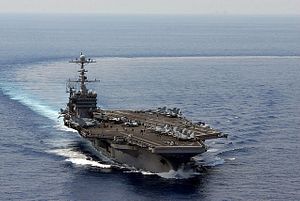In an ill-advised abundance of caution, the Obama administration may be establishing a dangerous precedent and setting the stage for an unnecessary confrontation with China in the South China Sea.
The issue is China’s artificial island-building and militarization, and its entirely unfounded maritime sovereignty claims based on those manmade “land features.” China’s actions are directly contrary to the United Nations Law of the Sea Convention, which it has signed but whose provisions it flouts. (Conversely, the U.S. has not ratified UNCLOS, but honors its standards as consonant with customary international law.)
China’s excessive maritime claims are precisely the kind of unilateral actions the U.S. Navy’s Freedom of Navigation (FON) program was designed to counter. Periodically, the Navy sends ships through international waters unlawfully claimed by one coastal nation or another in order to preclude any misunderstanding regarding universal navigational rights or any semblance of acquiescence in the offending nation’s claims.
The principle applies as well to the right of overflight in international airspace where China and others have tried to exclude U.S. aircraft from conducting normal reconnaissance missions that are clearly outside the country’s 12-mile territorial limits. U.S. aircraft routinely conduct such flights despite those objections.
Similarly, when Beijing unilaterally declared an air defense identification zone (ADIZ) in the South China Sea, Washington immediately asserted its overflight rights by dispatching (unarmed) B-52s through the space. (Unfortunately, it diluted its message by simultaneously advising U.S. civilian flights to comply with China’s notification demands.)
The South China Sea has been a different story. Despite numerous statements by U.S. officials that China’s island reclamation program and related territorial claims violate UNCLOS and customary international law, no U.S ships have entered the contested waters.
The administration, and even experts who criticize it for lacking a strategy to counter Chinese expansionism, worry that U.S. action will be seen by China, and perhaps others, as provocative. But continued inaction – for example, while long-term diplomatic negotiations pursue shared use of regional resources – can produce unintended adverse consequences.
Experience with America’s intermittent presence in the Taiwan Strait is instructive. In the postwar period, long before there was a FON program, Washington saw little strategic value in the status of Taiwan and the U.S. Navy was largely absent from the area. When Secretary of State Dean Acheson seemed to write off Taiwan and South Korea as periperal US strategic interests, the Korean War erupted.
President Truman found it necessary to deploy the Seventh Fleet to the Taiwan Strait to deter Mao Zedong’s declared intent to take Taiwan by force, as well as Chiang Kai-shek’s professed desire to invade the Mainland.
Routine U.S. Navy operations in the Strait, augmented by the 1954 US-Taiwan Mutual Defense Treaty, kept the peace for the next two decades despite occasional episodes of Chinese shelling of Quemoy and Matsu.
In 1971, to pave the way for his trip to China, U.S. President Richard Nixon decided to show his goodwill by withdrawing the Seventh Fleet from the Strait. It stayed out as successive administrations sought to foster U.S.-China relations. But when China fired missiles across the Strait in 1995 to protest a U.S. visit by Taiwan’s President Lee Teng-hui, President Bill Clinton sent two carrier battle groups through the Strait. Outraged Chinese officials threatened a “sea of fire” if it happened again and warned that the U.S. should “care more about Los Angeles than Taiwan.”
Washington tried to mollify Beijing by “explaining” that the transit was merely caused by a “weather diversion,” implicitly conceding that China was entitled to object. The scenario threatened to repeat itself when Beijing again fired missiles to protest Taiwan’s first direct presidential election in March 1996, and Clinton again sent a carrier battle group to the region. But this time, apparently heeding China’s warning, the ships did not enter the Strait.
The Navy stayed out of the Strait for the next decade either because of the residual influence of earlier White House/State Department caution or because commanders decided on their own to avoid antagonizing China. Ship commanders steered clear of the Strait even when adverse weather conditions made that route operationally safer. When the situation was brought to the attention of Defense Secretary Donald Rumsfeld in 2005, President George W. Bush directed the Navy to return to regular passages through the Strait.
China was not pleased with the new policy nor with the coincidental pro-independence rhetoric of Chen Shui-bian’s government on Taiwan. In 2007, Beijing denied Hong Kong port calls both for a previously approved Thanksgiving visit and for U.S. Navy minesweepers in distress.
The Pentagon protested to the Chinese and the USS Kitty Hawk battle group sailed through the Taiwan Strait en route to Japan. Beijing strongly objected and Admiral Thomas Keating, Pacific Commander stated: “We don’t need China’s permission to go through the Taiwan Strait. It’s international water. We will exercise our free right of passage whenever and wherever we choose as we have done repeatedly in the past and will do in the future.”
It is long past time for a similar demonstration of U.S. resolve regarding the artificial islands and the artificial crises Beijing is creating in the South China Sea.
Joseph A. Bosco is a member of the U.S.-China task force at the Center for the National Interest and a senior associate at the Center for Strategic and International Studies. He previously served as China country desk officer in the office of the secretary of Defense from 2005-2006.
































